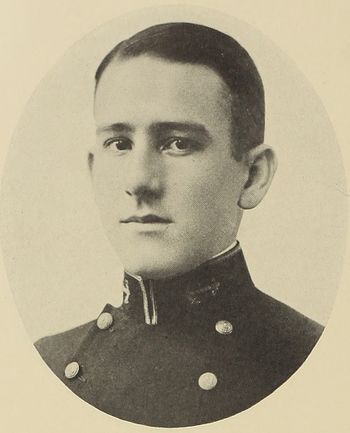THOMAS E. ZELLARS, LT, USN
Thomas Zellars '21
Lucky Bag
From the 1921 Lucky Bag:
Thomas Edward Zellars
Grantville, Georgia
"Tommie" "Dixie Dew Drop" "Roue"
ISN'T he handsome, though? And, girls, just think, he seldom drags. The only thing besides the weak squad that is capable of enticing him over to the gym is a girl from Georgia.
That natural brace and snappy step admired by us Plebe summer were the result of training at Culver, where Tommie received his childhood education.
Tommie's savviness was demonstrated Plebe year. Since then he has been content to loaf along on his reputation, but is always well up in things Academic. Tommie is the possessor of a geniality that is enviable. His perpetual good humor and ability to take failure as well as success with the same composure is quite an accomplishment.
We didn't all know him at first, but his quiet, unassuming, courteous manner soon won him a warm place in the hearts of everyone.
Buzzard.
The Class of 1921 was the last of the wartime-accelerated classes. "1921A" was graduated on June 3, 1920; the second half, "1921B", was graduated on June 2, 1921. Thomas was graduated with 1921A.

Thomas Edward Zellars
Grantville, Georgia
"Tommie" "Dixie Dew Drop" "Roue"
ISN'T he handsome, though? And, girls, just think, he seldom drags. The only thing besides the weak squad that is capable of enticing him over to the gym is a girl from Georgia.
That natural brace and snappy step admired by us Plebe summer were the result of training at Culver, where Tommie received his childhood education.
Tommie's savviness was demonstrated Plebe year. Since then he has been content to loaf along on his reputation, but is always well up in things Academic. Tommie is the possessor of a geniality that is enviable. His perpetual good humor and ability to take failure as well as success with the same composure is quite an accomplishment.
We didn't all know him at first, but his quiet, unassuming, courteous manner soon won him a warm place in the hearts of everyone.
Buzzard.
The Class of 1921 was the last of the wartime-accelerated classes. "1921A" was graduated on June 3, 1920; the second half, "1921B", was graduated on June 2, 1921. Thomas was graduated with 1921A.
Loss
From of the US Naval Academy:
LTJG Zellars' assigned battle station position was turret commander in Mississippi's 14 inch, No. 2 turret. Ensign McCrea and Erwin were also assigned to the turret. On June 12, 1924, while the battleship was engaged in gunnery practice off San Pedro, California, an explosion and fire engulfed their turret. LTJG Zellars, Ensign McCrea and Erwin and 45 others were asphyxiated almost immediately but not before LTJG Zellars turned on the flood valve which extinguished a burning powder train—an act which undoubtedly saved the ship and many of his shipmates from destruction.
On June 12, 1924, the Mississippi, along with the battleships USS Tennessee (BB-43) and USS Idaho (BB-42), were engaged in gunnery practice off San Clemente Island. The ships were simulating a chase, firing only their forward turrets at close range. Battleship USS California (BB-44) towed a large target. The gunners on all three battlewagons were competing for a $20 prize that Congress had voted to award the fleet's most proficient naval marksman. The Mississippi enjoyed a reputation for collecting gunnery awards, and the day before had hit 52 out of 55 targets. Several salvos were fired by each ship, but then there was trouble with "Missy's" number two turret. The right gun had just fired and was returned to loading position and the plug opened. The next shell was rammed into the gun and the four powder bags on the spanner tray were rammed into place behind it. As the rammer was withdrawn, there emerged from the breech a small grayish ball of smoke and flame followed by a large flash. Flame and gases immediately filled the gun compartment, passed through the safety doors above the shell table to the other two gun compartments and through the peep doors to the turret officer's booth. Almost instantly, forty-five men and three officers were dead from asphyxiation. It was one of the worst disasters suffered by the Navy during peacetime.
An inquiry found that there had been inadequate air pressure forced through the gun to expel the incandescent gases and other flammable residue after firing. Smoldering material left in the gun had ignited the powder charge of the next shot. The flames and gases had overcome the men so quickly that recovery crews found many of the men still at their positions. One man who was recognized as a hero of the disaster and credited with saving the ship was the turret captain, LTJG Zellars. He had instinctively closed the doors to the ammunition hoist and flooded the magazines. When his body was discovered, his hand was still clutching the flood control.
…
Funeral services were held June 17, 1924 on Trona Field in San Pedro, California the home of the Pacific Fleet. Forty-seven coffins were arranged on the field. Lieutenant Zellars' body had already been sent to Georgia for burial. Vice Admiral Henry A. Wiley (USNA 1888) and Rear Admiral William V. Pratt (USNA 1889) presided over the ceremony. Naval officers in dress uniforms stood in front as 1200 sailors in dress blues stood on the sides of the coffins. Two hundred sailors of each battleship of Battleship Division 4 were present. Another 2700 sailors observed the services. A seven man Marine rifle squad fired three volleys.
Although investigators concluded that a faulty gas-ejection system prevented one of the gun's breech plugs from closing securely, thereby permitting a jet of flame to spurt back into the powder-filled room when a salvo was fired. Investigators also found that some access safety doors inside the turret had been left partly open. Also, the crew failed to examine one or more of the gun bores and call out "Bore clear!"--another violation of regulations.
…
LTJG Zellars is also remembered in Dahlgren Hall, at the United States Naval Academy with a plaque from his Naval Academy classmates.
Other Information
From researcher Kathy Franz:
Thomas graduated from Culver Military Academy. He was appointed to take the Naval Academy examination by Senator Hardwick in April, 1916, but he declined it.
After taking a naval preparatory course in a Baltimore school, he attended the Naval Academy.
He married Mary Gresham.
Thomas is buried in Georgia.
Memorial
Joseph's classmates erected a plaque in his honor in Memorial Hall. It reads in part:
His hand was found grasping the flood valve which extinguished a burning powder train and saved his ship. Flaming death was not as swift as his sense of duty and his will to save his comrades at any cost to himself. His was the spirit that makes the service live.
Namesake
USS Zellars (DD 777) was named for Thomas; the ship was sponsored by his widow.
Related Articles
William McCrea '22 and Marcus Erwin, Jr. '23 were also lost in this explosion.
The "Register of Commissioned and Warrant Officers of the United States Navy and Marine Corps" was published annually from 1815 through at least the 1970s; it provided rank, command or station, and occasionally billet until the beginning of World War II when command/station was no longer included. Scanned copies were reviewed and data entered from the mid-1840s through 1922, when more-frequent Navy Directories were available.
The Navy Directory was a publication that provided information on the command, billet, and rank of every active and retired naval officer. Single editions have been found online from January 1915 and March 1918, and then from three to six editions per year from 1923 through 1940; the final edition is from April 1941.
The entries in both series of documents are sometimes cryptic and confusing. They are often inconsistent, even within an edition, with the name of commands; this is especially true for aviation squadrons in the 1920s and early 1930s.
Alumni listed at the same command may or may not have had significant interactions; they could have shared a stateroom or workspace, stood many hours of watch together… or, especially at the larger commands, they might not have known each other at all. The information provides the opportunity to draw connections that are otherwise invisible, though, and gives a fuller view of the professional experiences of these alumni in Memorial Hall.
January 1921
July 1923
September 1923
November 1923
January 1924
March 1924
May 1924

The "category" links below lead to lists of related Honorees; use them to explore further the service and sacrifice of alumni in Memorial Hall.